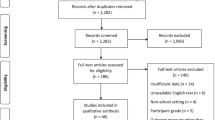Abstract
Self-regulation and other student-directed learning strategies have the potential to benefit students with developmental disabilities and mental retardation in general education classrooms. However, to date, there is little information about use of such strategies in general education classrooms, particularly at the secondary education level. This study examined the effect of a self-regulation multicomponent process (antecedent cue regulation or self-monitoring with self-evaluation and self-reinforcement) with 3 students with developmental disabilities in typical classrooms. Use of the self-regulation strategies improved adaptive behaviors related to class participation or decreased problem behaviors for all students. Also, teachers working with students indicated that they had exceeded their expectations for achieving goals related to the target behaviors. The potential for use of self-regulation strategies to promote successful inclusion is discussed.
Similar content being viewed by others
References
Agran, M., Alper, S., and Wehmeyer, M. L. (2002a). Access to the general curriculum for students with significant disabilities: What it means to teachers. Educ. Train. Ment. Retard. Dev. Disabil. 37: 123–133.
Agran, M., Blanchard, C., Hughes, C., and Wehmeyer, M. L. (2002b). Increasing the problem-solving skills of students with severe disabilities participating in general education. Remed. Spec. Educ. 23: 279–288.
Agran, M., Blanchard, C., Wehmeyer, M. L., and Hughes, C. (2001). Teaching students to self-regulate their behavior: The differential effects of student-versus teacher-delivered reinforcement. Res. Deve. Disabil. 22: 319–332.
Cardillo, J. E. (1994). Summary score conversion key. In Kiresuk, T. J., Smith, A., and Cardillo, J. E. (Eds.), Goal Attainment Scaling: Applications, Theory and Measurement, Erlbaum, Hillsdale, NJ, pp. 273–281.
Carr, R. W. (1979). Goal attainment scaling as a useful tool for evaluating progress in special education. Except. Child. 46: 88–95.
Copeland, S. R., Hughes, C., Agran, M., Wehmeyer, M. L., and Fowler, S. E. (2002). An intervention package to support high school students with mental retardation in general education classrooms. Am. J. Ment. Retard. 107: 32–45.
Gilberts, G., Agran, M., Hughes, C., & Wehmeyer, M. (2001). The effects of peer-delivered self-monitoring strategies on the participation of students with severe disabilities in general education classrooms. J. Assoc. Pers. Sev. Handic. 26: 25–36.
Hughes, C., Copeland, S. R., Agran, M., Wehmeyer, M. L., Rodi, M., and Presley, J. A. (2002). Using self-monitoring to improve performance in general education high school classes. Educ. Train. Ment. Retard. Dev. Disabil. 37: 262–271.
King-Sears, M. E. (1999). Teacher and researcher co-design self-management content for an inclusive setting: Research training, intervention, and generalization effects on student performance. Educ. Train. Ment. Retard. Dev. Disabil. 34: 134–156.
Kiresuk, T. J., and Lund, S. H. (1976). Process and measurement using goal attainment scaling. In Glass, G. V. (ed.), Education Studies Review Manual, Vol. 1, Sage, Beverly Hills, CA.
McConnell, M. E. (1999). Self-monitoring, cueing, recording, and managing: Teaching students to manage their own behavior. TEACHING Except. Child. 34(2): 14–21.
McDougall, D., & Brady, M. (1998). Initiating and fading self-management interventions to increase math fluency in general education classes. Except. Child. 64: 151–166.
Snyder, M. C., and Bambara, L. C. (1997). Teaching secondary students with learning disabilities to self-manage classroom survival skills. J. Learn. Disabil. 30(5): 534–543.
Wehmeyer, M. L., Hughes, C., Agran, M., Bolding, N., and Yeager, D. (manuscript submitted for publication). Promoting self-directed learning of adolescents with mental retardation in regular education classrooms: Goal setting and self-monitoring.
Wehmeyer, M. L., Lattin, D., and Agran, M. (2001). Access to the general curriculum for students with mental retardation: A decision-making model. Educ. Train. Ment. Retard. Dev. Disabil. 36: 329–344.
Wehmeyer, M. L., Sands, D. J., Knowlton, H. E., & Kozleski, E. B. (2002). Teaching Students With Mental Retardation: Promoting Access to the General Curriculum, Paul H. Brookes, Baltimore.
Author information
Authors and Affiliations
Rights and permissions
About this article
Cite this article
Wehmeyer, M.L., Yeager, D., Bolding, N. et al. The Effects of Self-Regulation Strategies on Goal Attainment for Students with Developmental Disabilities in General Education Classrooms. Journal of Developmental and Physical Disabilities 15, 79–91 (2003). https://doi.org/10.1023/A:1021408405270
Issue Date:
DOI: https://doi.org/10.1023/A:1021408405270




